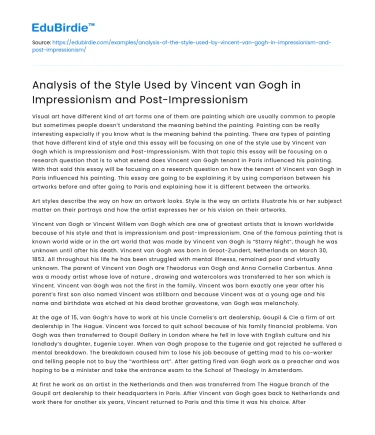Introduction
Vincent van Gogh, a pivotal figure in the transition from Impressionism to Post-Impressionism, is renowned for his bold colors, emotive expression, and distinctive brushwork. Born in 1853 in the Netherlands, Van Gogh's artistic journey was both tumultuous and transformative. While he initially dabbled in the Impressionist style, his work evolved, leading him to become one of the most influential Post-Impressionists. This essay explores Van Gogh's stylistic development, examining how his techniques and thematic concerns distinguished him from his contemporaries. By analyzing specific works and their contexts, we can better understand how Van Gogh's art bridged the gap between Impressionism's fleeting impressions and Post-Impressionism's emotive abstraction. Additionally, the essay considers counter-arguments regarding his classification within these movements, ultimately reinforcing the unique nature of his contribution to art history.
Impressionism and Van Gogh’s Early Influences
Van Gogh's initial exposure to Impressionism occurred during his time in Paris from 1886 to 1888, a period marked by significant artistic experimentation. Here, he encountered the works of Impressionists such as Claude Monet and Camille Pissarro, who emphasized capturing light and movement through vibrant colors and loose brushwork. This exposure deeply influenced Van Gogh, apparent in paintings like "Vase with Red Poppies" (1886), where he adopted lighter palettes and rapid brushstrokes to depict the ephemeral quality of flowers. However, unlike traditional Impressionists focused on the transient effects of light, Van Gogh's works began to reflect a more personal and emotional resonance.
Save your time!
We can take care of your essay
- Proper editing and formatting
- Free revision, title page, and bibliography
- Flexible prices and money-back guarantee
The Impressionist technique of plein air painting, or painting outdoors, also intrigued Van Gogh. He utilized this method to capture the countryside's natural beauty, as seen in "The Seine with the Pont de la Grande Jette" (1887). Yet, even in these works, Van Gogh's distinctive style began to emerge, marked by more intense colors and swirling patterns that hinted at his future departure from pure Impressionism. While some critics argue that Van Gogh's work during this time was merely derivative, a closer examination reveals a nascent individuality poised to redefine artistic conventions.
Transitioning to Post-Impressionism: A Unique Artistic Vision
As Van Gogh's style progressed, he gradually diverged from Impressionist ideals, embracing a more subjective approach that would later define Post-Impressionism. This shift is exemplified in his iconic painting "Starry Night" (1889), where swirling skies and vibrant blues convey intense emotional depth. Unlike Impressionists, whose works often sought to objectively capture the world, Van Gogh infused his canvases with personal symbolism and emotional intensity. The thick impasto technique, where paint is applied thickly to create texture, further differentiated his work, adding a tactile dimension that engaged viewers on multiple sensory levels.
Furthermore, Van Gogh's focus on emotional expression and symbolic content aligns with the Post-Impressionist movement's broader goals. Paul Gauguin, a contemporary and occasional collaborator, shared similar aspirations, seeking to transcend Impressionism's limitations through bold colors and symbolic subjects. Despite their shared goals, Van Gogh's approach was uniquely his own, characterized by a profound empathy for humanity and nature. His painting "The Night Café" (1888) exemplifies this, using clashing colors and distorted perspectives to evoke the unsettling atmosphere of the scene.
Reconciliation and Counter-Arguments
Critics often debate Van Gogh's classification as either an Impressionist or Post-Impressionist, arguing that his unique style defies strict categorization. Some suggest that his bold use of color and emotive brushwork placed him beyond the confines of any single movement. While these points are valid, they overlook how Van Gogh's work exemplifies the transitional nature between Impressionism and Post-Impressionism. His art embodies both the immediacy of Impressionist techniques and the emotive complexity of Post-Impressionist ideals.
Moreover, Van Gogh's legacy extends beyond these movements, influencing subsequent generations of artists, including the Expressionists. His unorthodox methods and emotional depth inspired figures like Edvard Munch, who sought to explore psychological experiences through art. Thus, while Van Gogh's work may resist easy classification, its impact on art history is undeniable, bridging crucial artistic developments and inspiring new directions.
Conclusion
In examining Vincent van Gogh's artistic journey, it becomes evident that his work represents a pivotal evolution from Impressionism to Post-Impressionism. His early engagement with Impressionist techniques provided a foundation for his later, more personal explorations of color and emotion. By transcending the limitations of Impressionism and embracing the emotive potential of Post-Impressionism, Van Gogh established a unique style that continues to captivate audiences. Though debates about his classification persist, Van Gogh's influence on art history remains indisputable, offering a testament to the power of artistic innovation and expression. His legacy endures, not only in the masterpieces he left behind but also in the inspiration he continues to provide to artists worldwide.






 Stuck on your essay?
Stuck on your essay?

